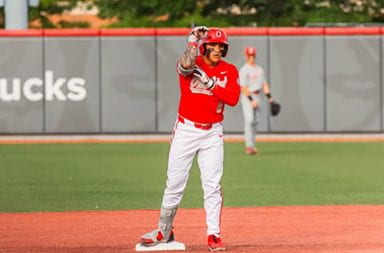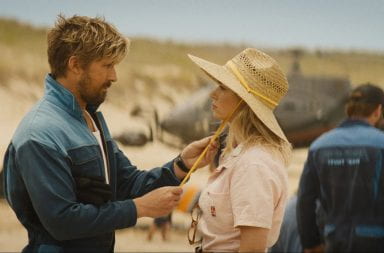
Isabella Liggett, a third-year in forensic biology, squats next to the 1,562 pound pumpkin she grew for the Giant Pumpkin Weigh-in. Courtesy of Caroline Stevens
Isabella Liggett skipped her midterm Wednesday to go to a show she had been anticipating for the past year. The Circleville Pumpkin show, that is.
It was there that the third-year in forensic biology was participating in the Giant Pumpkin Weigh-in, an annual event which begins the pumpkin show and consists of participants bringing in massive pumpkins (upwards of 1,000 pounds massive).
It was the first time Liggett entered a pumpkin into the weigh-in, after growing hers for months.
The pumpkin, named Luna, came in at 1,562 pounds. And Liggett took home second place. The first place winner had a pumpkin weighing 1,701 pounds.
“It was amazing and mind-blowing,” Liggett said. “I was just grateful to have a pumpkin to enter.”

Isabella Liggett’s pumpkin, named Luna, weighed in at 1,562 pounds at the Giant Pumpkin Weigh-in Wednesday. Courtesy of Caroline Stevens
Liggett comes from a family of pumpkin growers. Her grandparents each have won the Giant Pumpkin Weigh-in; her grandfather has been growing the fruit for 25 years.
But her first year growing was a rough one for the family.
“There was a disease in the pumpkin patch,” she said. “Dealing with that, there were a couple of times where I didn’t know if my plant would last.”
Call it first-time luck, but Luna the pumpkin made it to the show while Liggett’s veteran grandfather’s pumpkin did not.
To ensure Luna would survive, Liggett made sure to get to the pumpkin patch three to four days each week to check on diseased spots on the vine and re-treat them using a disinfecting spray.
To clarify, Luna isn’t an ordinary pumpkin and neither are many of the fruits entered in the big weigh-in.
“We control the genetics,” Liggett explained.
She said the Liggett family pollinates its pumpkins directly, doing the work of most bees, and starts the plant inside for one week before burying the vines outside.
After pollination in April, Liggett visited the pumpkin patch three to four days each week during the summer — on top of taking summer courses and working a full-time job — to care for it.
When school started, the full-time student traveled to her family’s Circleville farm two days a week.
“Care can take two to five hours depending on the day and work to be done,” she said. “When you get more towards September and October there’s less work to do, but the main thing I was doing was checking on the diseased vine spots.”
Liggett said the hard work paid off after winning second place, and she plans to continue her family’s legacy by entering into the Giant Pumpkin Weigh-in for years to come.
As for the midterm she skipped, Liggett’s professor let her take the exam early. “It went pretty well,” she said.


